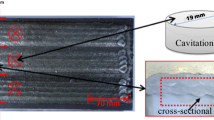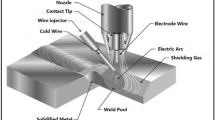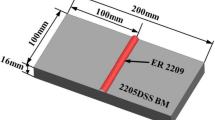Abstract
The control of cavitation erosion wear is a hindrance concerning the maintenance of hydraulic equipment’s. The most used consumables to fill eroded areas are cobalt-based austenitic steels, commercially known as “Stellites”. The current study carried out analysis of the coatings deposited via the new cold wire gas metal arc welding (CW-GMAW) process. The coatings were deposited via CW-GMAW process, variating three levels of addition wire feeding speed. The coating consisted in a three-layer deposit; the first two with an AWS ER 309L wire, via GMAW process, and the third layer employed the interaction between AWS ER 309L and Stellite 21 E wires, via CW-GMAW process. The coatings obtained an increase in cobalt values, with silicon and molybdenum variations, as well as the iron value reduction for each used feeding variation. The coatings were subjected to an accelerated erosion test, according to ASTM G32 Standards. The best obtained result corresponded to the coating with 7.2 m/min additional speed.













Similar content being viewed by others
References
Sreedhar BK, Albert SK, Pandit AB (2015) Cavitation erosion testing of austenitic stainless steel (316L) in liquid sodium. Wear 328–329:436–442. https://doi.org/10.1016/j.wear.2015.03.009
Escaler X, Egusquiza E, Farhat M et al (2006) Detection of cavitation in hydraulic turbines. Mech Syst Signal Process 20:983–1007. https://doi.org/10.1016/j.ymssp.2004.08.006
Franc JP, Michel JM (2004) Fundamentals of cavitation
Kumar P, Saini RP (2010) Study of cavitation in hydro turbines—a review. Renew Sustain Energy Rev 14:374–383. https://doi.org/10.1016/j.rser.2009.07.024
Peters A, Sagar H, Lantermann U, el Moctar O (2015) Numerical modelling and prediction of cavitation erosion. Wear 338–339:189–201. https://doi.org/10.1016/j.wear.2015.06.009
Xiaojun Z, Procopiak LAJ, Souza NC, d’Oliveira ASCM (2003) Phase transformation during cavitation erosion of a Co stainless steel. Mater Sci Eng, A 358:199–204. https://doi.org/10.1016/s0921-5093(03)00297-1
Richman RH, Mcnaughton WP (1990) Correlation of cavitation erosion behavior with mechanical properties of metals. Wear 140:63–82. https://doi.org/10.1016/0043-1648(90)90122-q
da Silva HR (2014) Aspectos operacionais de revestimentos soldados: desgaste erosivo e cavitação. Universidade Federal de Uberlândia, Uberlândia
Cabral TS, Braga EM, Mendonça EAM, Scott A (2015) Influence of procedures and transfer modes in MAG welding in the reduction of deformations on marine structure panels. Weld Int 29:928–936. https://doi.org/10.1080/09507116.2014.932993
Ribeiro RA, Santos EBF, Assunção PDC et al (2015) Predicting weld bead geometry in the novel CW-GMAW process. Weld J 94:301s–311s
Li KH, Chen JS, Zhang YM (2007) Double-electrode GMAW process and control. Weld J 86:231s–237s
Li KH, Zhang YM (2008) Consumable double-electrode GMAW—Part l: the process. Weld J 87:11s–17s
Li KH, Zhang YM (2008) Consumable double-electrode GMAW part II: monitoring, modeling, and control. Weld J 87:44s–50s
Lu Y, Zhang YM, Kvidahl L (2013) Heat input reduction in fillet welding using bypass and root opening. Weld J 92:390s–400s
Lu Y, Chen S, Shi Y et al (2014) Double-electrode arc welding process: principle, variants, control and developments. J Manuf Process 16:93–108. https://doi.org/10.1016/j.jmapro.2013.08.003
Silva FG (2010) Estudo da viabilidade do processo de soldagem FCAW com adição de arame frio aplicado a indústria naval. Universidade Federal do Pará, Belém
Cabral TS, Cruz L, Silva FG, Braga EM (2011) Desenvolvimento e estudo da viabilidade de um injetor de arame adicional para o processo de soldagem Mig/Mag e FCAW. In: 6th Brazilian conference on manufacturing engineering. Caxias do Sul, RS
Hattori S, Mikami N (2009) Cavitation erosion resistance of stellite alloy weld overlays. Wear 267:1954–1960. https://doi.org/10.1016/j.wear.2009.05.007
ASTM G32 (2016) Standard test method for cavitation erosion using vibratory apparatus. Annual Book of ASTM Standards 20. https://doi.org/10.1520/g0032-16
Niederhofer P, Huth S, Theisen W (2015) Cavitation erosion and hydroabrasion resistance of cold work tool steels produced by powder metallurgy. Wear 332–333:1059–1069. https://doi.org/10.1016/j.wear.2014.12.016
Kishor B, Chaudhari GP, Nath SK (2014) Cavitation erosion of thermomechanically processed 13/4 martensitic stainless steel. Wear 319:150–159. https://doi.org/10.1016/j.wear.2014.07.024
Light KH (2005) Development of a cavitation erosion resistant. The University of Maine, Orono
Assunção PDC (2013) Estudo da viabilidade do processo de soldagem GMAW-DCW (Double Cold Wire). Universidade Federal do Pará, Belém
Woodford DA, Beattie HJ (1971) A deformation-induced phase transformation involving a four-layer stacking sequence in a Co–Fe alloy. Metall Mater Trans B 2:3223–3225. https://doi.org/10.1007/bf02814976
Reed-Hill RE (1982) Principios de metalurgia física, 2o ed. Gb. Dois, Rio de Janeiro
Geddes B, Leon H, Huang X (2010) Superalloys: alloying and performance. ASM International Materials Park, Ohio
Antony KC (1983) Wear-resistant cobalt-base alloys. JOM 35:52–60. https://doi.org/10.1007/bf03338205
Matthews SJ, Crook P, Flasche LH, Tackett JW (1991) Weldability characteristics of a new corrosion and wear-resistant cobalt alloy. Weld J Res Suppl 70:331–338
Ribeiro HO, de Buschinelli AJ, JC Dutra, D’Oliveira ASCM (2010) Resistência à erosão por cavitação de aços inoxidáveis austeníticos CrMnSiN depositados por PTA. Soldag e Insp 15:121–129. https://doi.org/10.1590/s0104-92242010000200006
Boccanera L, Barra SR, Buschinelli AJ de A et al (1998) Influência do Acabamento Superficial, Porosidade e Diluição Sobre a Resistência à Cavitação de Revestimentos Soldados. Congr Ibero-Americano Soldag V
Allenstein ÂN (2007) Estudo da resistência à cavitação do aço inoxidável martensítico Ca6-Nm nitretado por plasma. Universidade Federal do Paraná, Curitiba
Krella A (2011) An experimental parameter of cavitation erosion resistance for TiN coatings. Wear 270:252–257. https://doi.org/10.1016/j.wear.2010.10.065
Iwai Y, Okada T, Tanaka S (1989) A study of cavitation bubble collapse pressures and erosion part 2: estimation of erosion from the distribution of bubble collapse pressures. Wear 133:233–243. https://doi.org/10.1016/0043-1648(89)90038-0
Barik RC, Wharton JA, Wood RJK, Stokes KR (2009) Electro-mechanical interactions during erosion-corrosion. Wear 267:1900–1908. https://doi.org/10.1016/j.wear.2009.03.011
Yong X, Xiao N, Shen H, Song Y (2016) Responses of the corroded surface layer of austenitic stainless steel to different corrosive conditions under cavitation. Mater Sci Eng, A 671:118–126. https://doi.org/10.1016/j.msea.2016.06.019
Santa JF, Blanco JA, Giraldo JE, Toro A (2011) Cavitation erosion of martensitic and austenitic stainless steel welded coatings. Wear 271:1445–1453. https://doi.org/10.1016/j.wear.2010.12.081
Lopez D, Alonso Falleiros N, Paulo Tschiptschin A (2011) Effect of nitrogen on the corrosion–erosion synergism in an austenitic stainless steel. Tribol Int 44:610–616. https://doi.org/10.1016/j.triboint.2010.12.013
Kwok CT, Man HC, Cheng FT (1998) Cavitation erosion and damage mechanisms of alloys with duplex structures. Mater Sci Eng, A 242:108–120. https://doi.org/10.1016/s0921-5093(97)00514-5
Kwok CT, Man HC, Cheng FT (1998) Cavitation erosion of duplex and super duplex stainless steels. Scr Mater 39:1229–1236. https://doi.org/10.1016/s1359-6462(98)00308-x
Levin BF, Dupont JN, Marder AR (1995) Weld overlay coatings for erosion control. Wear 181–183:810–820. https://doi.org/10.1016/0043-1648(95)90200-7
Jiménez LBV (2014) Estudo dos micromecanismos de dano por cavitação em aço inoxidável UNS S 31803 de alto teor de nitrogênio com e sem encruamento. Escola Politécnica da Universidade de São Paulo, São Paulo
RODRIGUES LAS (2011) Caracterização microestrutural e de propriedades mecânicas de soldas do aço ASTM A 131 pelos processos FCAW convencional e com adição de arame frio. Universidade Federal do Pará, Belém
FERREIRA ASA (2014) A influência do teor de silício na microestrutura e propriedades mecânicas do aço ASTM 131-GRAU A soldado por GMAW-CW e GMAW-DCW. Universidade Federal do Pará, Belém
Bregliozzi G, Di Schino A, Ahmed SIU et al (2005) Cavitation wear behaviour of austenitic stainless steels with different grain sizes. Wear 258:503–510. https://doi.org/10.1016/j.wear.2004.03.024
Acknowledgements
To the Federal University of Pará, and to the Laboratory of Metallic Materials Characterization (LCAM), where the presented experiments could be performed. A special thanks to the teacher and counselor Eduardo Braga, for the technical assistance, and to Capes, CNPQ and PROPESP/UFPA for the financial support.
Funding
Funding was provided by Coordenação de Aperfeiçoamento de Pessoal de Nível Superior (BR).
Author information
Authors and Affiliations
Corresponding author
Additional information
Technical Editor: Márcio Bacci da Silva.
The original version of this article was revised. The co-author's surname should read as “Sileno Espíndula Dias".
Rights and permissions
About this article
Cite this article
Cabral, T.d., Dias, S.E., Filho, A.A.C. et al. Influence of a cobalt-based wire injection in austenitic coating deposited via CW-GMAW. J Braz. Soc. Mech. Sci. Eng. 40, 461 (2018). https://doi.org/10.1007/s40430-018-1384-1
Received:
Accepted:
Published:
DOI: https://doi.org/10.1007/s40430-018-1384-1




